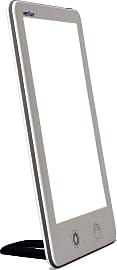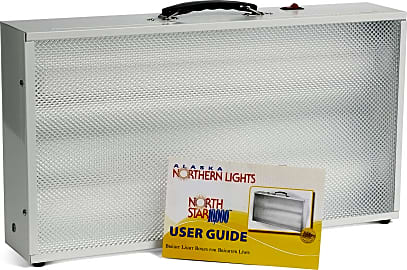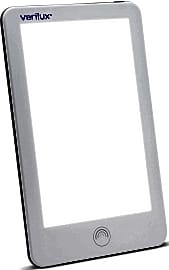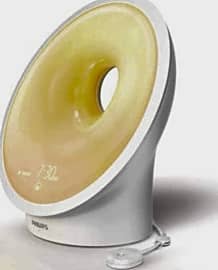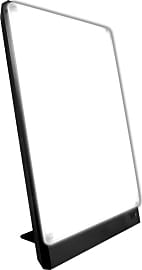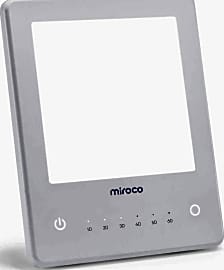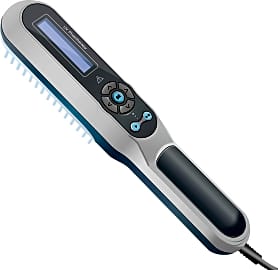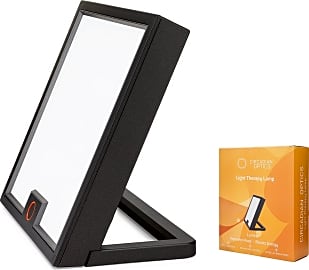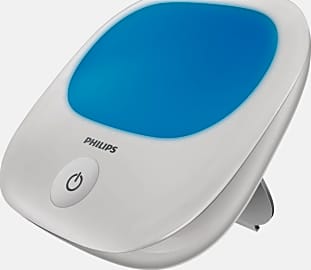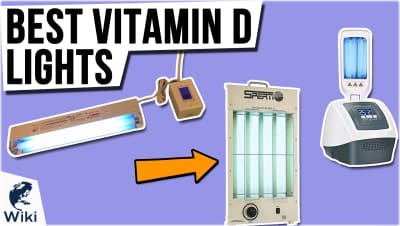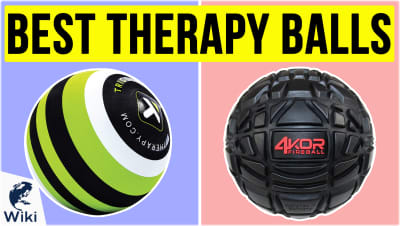The 10 Best Therapy Lamps

This wiki has been updated 41 times since it was first published in April of 2015. Light therapy is widely used worldwide and shows some effectiveness in treating symptoms of dermatitis, low energy and social affective disorder. If, like many, you're interested in non-drug-based remedies with few to no adverse side effects, one of these SAD lamps may help with a variety of conditions. Because they are medical devices, only use them under the guidance of a qualified professional. When users buy our independently chosen editorial selections, we may earn commissions to help fund the Wiki.
Editor's Notes
October 19, 2020:
It’s important to remember that therapy lamps are medical equipment and should only be used as directed by healthcare professionals. When used properly, these devices can improve skin disorders, treat Seasonal Affective Disorder, and boost energy levels.
If you’re looking to relieve problems like psoriasis or eczema, your doctor may direct you towards a UVB lamp. While these lights block UVA rays, they can still be harmful to the skin if overused, so caution is recommended. The Teenvix Hand-Held, which is no longer available, was replaced with the Angel Kiss Wand. Like the previously listed item, this model is a handheld device that uses UV light.
If you’ve been diagnosed with SAD, you’ll want to get a UV-free model with at least 10,000 lux, like the Northern Light Technology Boxelite. Though quite expensive, it emits light up to 14 inches and is one of the best on our list. With regards to other UV-free options, we replaced the Carex Day-Light Sky Bright with the newer and bigger Carex Classic Plus. While they’re both great models, the Carex Classic Plus has a larger 13.5 by 15.5 inch surface, is less bulky, and costs about the same.
If your circadian rhythm is off due to frequent travel, you may want a portable model to take with you on trips. At only 1.3 pounds, the Verilux HappyLight VT31 is travel-friendly and lightweight. Another good travel option is the compact Philips GoLite, which features a small square shape and can be tucked into a suitcase. Lastly, we replaced the outdated Travelite with the much newer Miroco MI-CL003. It is just as compact as the former, but offers a sleeker design and provides UV-free LED bulbs instead of florescents.
Some medical professionals suggest using your therapy lamp as soon as possible after waking up. The aforementioned Philips GoLite is small enough for your bedside table, which may encourage morning use. Likewise, the Philip’s Smartsleep, which is newly added to our list, functions as an alarm clock and can be programed to emit light as you’re waking up.
October 03, 2019:
First off, medical devices like light therapy lamps should only be used as directed by a qualified medical professional. If you've been given such advice by a doctor, know that there are two types of light therapy you can undergo at home. Many sufferers of acute skin problems like psoriasis, eczema, and vitiligo find relief from UVB phototherapy, which provides the benefit of sunshine without the dangers of UVA rays. These require a particular level of caution because using them too much can still result in sunburn and other skin damage, despite the lack of UVA radiation. But as long as you use them properly, they're quite safe and can provide healing that you might not be able to get from creams or other chemical-based solutions. The Sperti is the top free-standing UVB phototherapy lamp, and the Teenvix is the most reliable hand-held option around.
For Seasonal Affective Disorder, you'll want a UV-free lamp, and you'll want a bright one. The Day-Light and both Veraluxes are great desktop models, though one Veralux is much brighter than the other. If you can afford it, the Boxelite is one of the best, and they're one of the few companies to advertise the distance at which 10,000 lux is produced. Alaska Northern Lights also publishes that number, and at 24 inches, their NorthStar just about the strongest we found. Smaller options like the Circadian Optics and Philips are decent for desktop use, but you'll have to be pretty close to them to get the full effect. If you don't have enough room to set one down, consider getting a floor-standing model.
How A Therapy Lamp Works
One condition that responds quite positively to light therapy is psoriasis.
Light therapy is the process of sitting near a lamp that in some way mimics natural light or emits certain wavelengths of light. There are different types of lights that can be used in therapy lamps, including fluorescent, polychromatic polarized (often used in the treatment of carpal tunnel syndrome), and full-spectrum. A doctor will typically prescribe these lamps to an individual for a very specific amount of time each day, depending on the condition being treated.
Therapy lamps meant for home use are often referred to as light boxes. They're much brighter than regular lamps, sometimes emitting up to 10,000 lux of light, so they usually have built-in eye protective technology. Those that depend on specific wavelengths are not as bright, and usually send out light in the blue and green areas of the visible spectrum.
One of the most common uses of light therapy lamps is the treatment seasonal mood disorder (SAD). Since individuals who live in areas with severe winters don't get as much sun-produced vitamin D as they need, these lamps can mimic time spent outdoors. But therapy lamps work on multiple levels of SAD. They can also help reset someone's internal clock, helping them sleep better, which can in turn fight depression and feelings of fatigue.
Light therapy lamps are also effective in treating certain skin conditions. When therapy lamps are used to treat skin conditions, it is called phototherapy. People can either receive full body phototherapy at a doctor's office or purchase a therapy lamp if they only need to treat certain areas of their skin. One condition that responds quite positively to light therapy is psoriasis. One of the symptoms of psoriasis is inflammation of the skin, brought on by the immune system's response to the condition. Using ultraviolet radiation on isolated parts of the body can suppress the immune system response there, and reduce inflammation. Light therapy, and specifically lamps that use lasers, has even been shown to provide some relief for acne sufferers.
When It's Better Than Medication
While there are over-the-counter and prescription medications for many of the conditions that therapy lamps treat, these medications can have unpleasant side effects that light therapy simply doesn't. Many people use these lamps to get over jet lag. Because the lamps suppress the production of melatonin, the chemical that makes us sleepy, they can help travelers adjust to their new time zone, without the need for excess amounts of coffee, or naps.
Therapy lamps can be a mild alternative to sleeping pills for people who suffer from sleep disorders.
Some people use the lamps in place of antidepressants. For example, it can be dangerous for a pregnant woman to take pharmaceutical antidepressants, and light therapy has proven to be a safe alternative to treating prepartum depression. Even non-pregnant individuals find that they can take a lower dose of antidepressants if they supplement them with time spent under a light box.
Therapy lamps can be a mild alternative to sleeping pills for people who suffer from sleep disorders. By simply doing their daily activities, like reading or typing on their computer, under a therapy lamp, insomniacs can slowly adjust their circadian rhythm. This can help them avoid the disruptive side effects of sleeping pills.
The History Of Light Therapy
Humans have always recognized that light is an important part of the healthy development of any living organism. As early as 1400 BCE, civilizations in Ancient Egypt, Rome and Greece harvested the therapeutic benefits of natural light. It wasn't until the late 1800s however, that people started using artificial light. It was around this time that the quartz lamp came to be, along with fluorescent tubes and the arc lamp.
Doctors first used these artificial lights in the treatment of diseases which used to plague humankind, like syphilis, pellagra, and tuberculosis.
Doctors first used these artificial lights in the treatment of diseases which used to plague humankind, like syphilis, pellagra, and tuberculosis. In the 1870s, a man named Augustus Pleasanton harnessed the power of blue light to stimulate the nervous system and alleviate pain associated with various conditions. In the 1890s, Neils Ryberg Finsen used red-light therapy in the treatment of smallpox and lupus.
Finsen would later be given a Nobel Prize for using ultra-violet light in the treatment of tuberculosis. Not long after, Dinshah Ghadiali would reveal his Spectro-Chrome system to the world, which is still widely used today. This system is based on the idea that certain colors in the light spectrum have a special relationship with certain parts of the body. In the 1920s, Harry Riley Spitler began to explore the benefits of light therapy on ocular disorders. Spitler is responsible for the principles of Syntonics, which uses light to balance the parasympathetic and sympathetic nervous systems.


